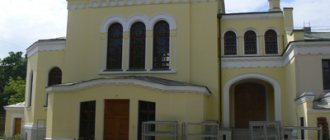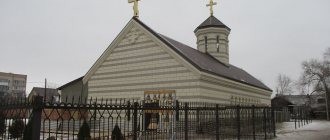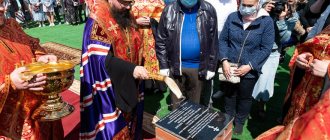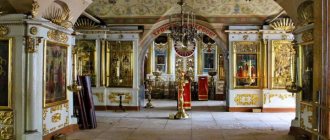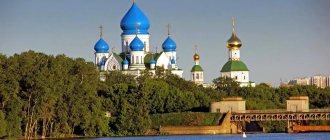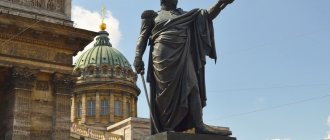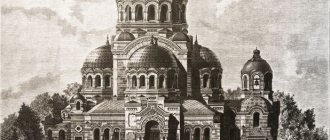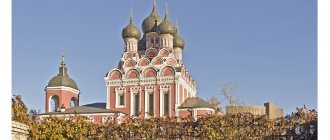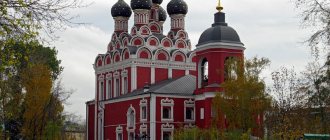Mir
Russia Moscow Temple of the Icon of the Mother of God “Consolation and Consolation” on Khodynskoye Field (Moscow) Map is loading...
{"format":"leaflet","minzoom":false,"maxzoom":false,"limit":50,"offset":0,"link":"all","sort":[""], "order":[],"headers":"show","mainlabel":"","intro":"","outro":"","searchlabel":"\u2026 \u0441\u043b\u0435\ u0434\u0443\u044e\u0449\u0438\u0435 \u0440\u0435\u0437\u0443\u043b\u044c\u0442\u0430\u0442\u044b","default":"","import-annotation":false,"width ":"auto","height":"350px","centre":{"text":"","title":"""link":"""lat":55.7805110999999982368535711430013179779052734375,"lon": 37.54678059999999817364368936978280544281005859375,"icon":""},"title":"","label":"","icon":"","lines":[],"polygons":[],"circles":[ ],"rectangles":[],"copycoords":false,"static":false,"zoom":8,"defzoom":14,"layers":["OpenStreetMap"],"image layers":[] ,"overlays":[],"resizable":false,"fullscreen":true,"scrollwheelzoom":true,"cluster":false,"clustermaxzoom":9,"clusterzoomonclick":true,"clustermaxradius":80, "clusterspiderfy":true,"geojson":"","clicktarget":"","showtitle":true,"hidenamespace":false,"template":"","userparam":"","activeicon": "","pagelabel":false,"ajaxcoordproperty":"","ajaxquery":"","locations":[{"text":"\u003Cb\u003E\u003Ca href=\"/palomnik/%D0% A5%D1%80%D0%B0%D0%BC_%D0%B8%D0%BA%D0%BE%D0%BD%D1%8B_%D0%91%D0%BE%D0%B6%D0%B8% D0%B5%D0%B9_%D0%9C%D0%B0%D1%82%D0%B5%D1%80%D0%B8_%C2%AB%D0%9E%D1%82%D1%80%D0% B0%D0%B4%D0%B0_%D0%B8_%D1%83%D1%82%D0%B5%D1%88%D0%B5%D0%BD%D0%B8%D0%B5%C2%BB_% D0%BD%D0%B0_%D0%A5%D0%BE%D0%B4%D1%8B%D0%BD%D1%81%D0%BA%D0%BE%D0%BC_%D0%BF%D0% BE%D0%BB%D0%B5_(%D0%9C%D0%BE%D1%81%D0%BA%D0%B2%D0%B0)\» title=\»\u0425\u0440\u0430\u043c\ u0438\u043a\u043e\u043d\u044b \u0411\u043e\u0436\u0438\u0435\u0439 \u041c\u0430\u0442\u0435\u0440\u0438 \u00ab\u041e\u0442\u0 440\u0430\u0434\u0430\u0438\ u0443\u0442\u0435\u0448\u0435\u043d\u0438\u0435\u00bb \u043d\u0430 \u0425\u043e\u0434\u044b\u043d\u0441\u043a\u043e\u043c \u0 43f\u043e\u043b\u0435 (\u041c \u043e\u0441\u043a\u0432\u0430)\»\u003E\u0425\u0440\u0430\u043c \u0438\u043a\u043e\u043d\u044b \u0411\u043e\u0436\u0438\u04 35\u0439\u041c\u0430\ u0442\u0435\u0440\u0438 \u00ab\u041e\u0442\u0440\u0430\u0434\u0430 \u0438 \u0443\u0442\u0435\u0448\u0435\u043d\u0438\u0435\u0 0bb\u043d\u0430\u0425\u043e\ u0434\u044b\u043d\u0441\u043a\u043e\u043c \u043f\u043e\u043b\u0435 (\u041c\u043e\u0441\u043a\u0432\u0430)\u003C/a\u003E\u003C /b\u003E\u003Chr/ \u003E\u003Ca href=\»/palomnik/%D0%A1%D0%B2%D0%BE%D0%B9%D1%81%D1%82%D0%B2%D0%BE:%D0%90%D0 %BD%D0%BD%D0%BE%D1%82%D0%B0%D1%86%D0%B8%D1%8F\" title=\"\u0421\u0432\u043e\u0439\u0441\u0442\u0432 \u043e:\u0410\u043d\u043d\u043e\u0442\u0430\u0446\u0438\u044f\»\u003E\u0410\u043d\u043d\u043e\u0442\u0430\u0446\u0438\u044f \u003C/a\u003E: »'\u0425\u0440\u0430\u043c \u0438\u043a\u043e\u043d\u044b \u0411\u043e\u0436\u0438\u0435\u0439 \u041c\u0430\u0442\u0435\u04 40\u0438\u00ab\u041e\u0442 \u0440\u0430\u0434\u0430 \u0438 \u0443\u0442\u0435\u0448\u0435\u043d\u0438\u0435\u00bb \u043d\u0430 \u0425\u043e\u0434\u044b \u043d\u0441\u043a\u043e\u043c '' 30\u043c,\u043f\u0440\ u0438\u043d\u0430\u0434\u043b\u0435\u0436\u0430\u0449\u0438\u0439 \u043a \u0412\u0441\u0435\u0445\u0441\u0432\u044f\u0442\u0 441\u043a\u043e\u043c\u0443\ u0431\u043b\u0430\u0433\u043e\u0447\u0438\u043d\u0438\u044e\u041c\u043e\u0441\u043a\u043e\u0432\u0441\u043a\u043e\u0439 \u0 433\u043e\u0440\u043e\u0434\ u0441\u043a\u043e\u0439 \u0435\u043f\u0430\u0440\u0445\u0438\u0438 \u0420\u0443\u0441\u0441\u043a\u043e\u0439 \u041f\u0440\u 0430\u0432\u043e\u0441\u043b\ u0430\u0432\u043d\u043e\u0439 \u0426\u0435\u0440\u043a\u0432\u0438.","title":"\u0425\u0440\u0430\u043c \u0438\u043a\u043e\u043d\u 044b\u0411\ u043e\u0436\u0438\u0435\u0439 \u041c\u0430\u0442\u0435\u0440\u0438 \u00ab\u041e\u0442\u0440\u0430\u0434\u0430 \u0438 \u0443\u 0442\u0435\u0448\u0435\u043d\ u0438\u0435\u00bb \u043d\u0430 \u0425\u043e\u0434\u044b\u043d\u0441\u043a\u043e\u043c \u043f\u043e\u043b\u0435 (\u041c\u043e\u 0441\u043a\u0432\u0430)" ,"link":"","lat":55.7805110999999982368535711430013179779052734375,"lon":37.54678059999999817364368936978280544281005859375,"icon":"" }],"imageLayers":[]}
55.780456; 37.546821
Russia, Moscow, Polikarpova street, 16
Moscow
Russia
Telephone
for inquiries: 8-926-265-25-06 (Nina)
Phones:
+7 (495) 945-37-46; +7 (985) 241-40-52 (priest on duty); +7 (495) 946-10-45 (phone number of the temple duty officer for calls at night)
Temple of the Icon of the Mother of God “Consolation and Consolation” on Khodynka Field
- an Orthodox church belonging to the All Saints Deanery of the Moscow City Diocese of the Russian Orthodox Church.
Temple of Otrada and Consolation on Khodynka Field today
This Orthodox cultural and spiritual center is located in Moscow on Polikarpova Street 16. It has several names: Temple of the Icon of the Mother of God “Joy and Consolation” (or Otrad Church); it is also called the Vatopedi Church. The people also have such a name - “Cossack” temple on Khodynka. This is a memorial temple of Russian pain.
Initially, it was created as a center of pain for Russian believers for the murdered innocents. It was erected in honor of the Moscow Governor-General, Grand Duke Sergei Alexandrovich, who fell at the hands of the terrorist Kalyaev. The church was founded on a symbolic date: on the prince’s 50th birthday after a memorial service at his grave.
The Vatopedi Church received its name from the fact that the Vatopedi Icon of the Mother of God bore the long-standing name “Joy and Consolation”, so the temple became a symbol of pain and consolation for those who lost their loved ones in the difficult years of the early twentieth century.
The church, once considered the most counter-revolutionary, has today become one of the centers of the spiritual life of believers and one of the most beloved cultural spaces in Moscow. Various religious events are often held at its base, where parishioners go with pleasure.
The building is interesting for its architectural design. This is an example of the culture of the Russian people and a unique attraction of Moscow, attracting the attention of many tourists. Today it is included in the list of the most luxurious churches in Moscow “Forty Forty”.
Externally, the building looks squat and small, but in fact, about 500 believers can be housed within its walls at the same time.
Recovery and restoration
In 1991, the temple was returned to the Orthodox Church. The building had not been renovated for 95 years and was in poor condition. The restoration of the temple began, which lasted throughout the nineties. On November 22, 1992, on the day of the celebration of the icon of the Mother of God “Quick to Hear,” the first prayer service was held. In October 1992, a wooden cross was installed on the temple, and in April 1994, a metal cross. The territory was cleared of former warehouse buildings, garbage was removed and utility rooms were built. A big event for the temple was the installation of a wooden iconostasis, for which icons were then painted, and temple icons of the Mother of God “Quick to Hear” and the healer Panteleimon were installed. In the 2000s, Panteleimon's chapel was also restored. On Holy Saturday, April 14, 2001, on the eve of Easter, His Holiness Patriarch Alexy II visited the temple.
Architect, exterior decoration, architectural ensemble
The Temple of Joy and Consolation on Khodynka Field was designed by the architect V. Adamovich. The style in which the temple was built is called Byzantine; the author imitated Balkan churches. In appearance and the number of vertical windows in the dome (there are 12 of them), the temple resembles the Church of the Twelve Apostles, built in Thessaloniki (Greece) at the beginning of the 14th century.
Church of the Twelve Apostles, Thessaloniki (Greece)
V. Adamovich visited Mount Athos several times, where he got the idea to design a temple in the style of the early Byzantine Empire, which differed from modern trends.
The main building is supported by 4 imposing pillars (pillars) of red and yellow brick, placed on the sides, on which are located small domes. The façade has striped masonry. This is also a feature of the Byzantine style.
In the western part of the building above the entrance there is an elaborate bell tower.
The preparation of the iconostasis, as well as the development of the internal and external decoration, was carried out by the icon painter and restorer, architect V. Guryanov. The architect V. Mayat, V. Adamovich’s co-author of many architectural projects, was also involved in the work.
In the 2000s, the iconostasis of the temple was replenished with new works made in the workshop founded by T. Trubnikova.
Soviet time
In the early 20s, the temple was closed, the wooden church of St. Panteleimon was demolished. The dome and top of the belfry of the stone temple were also broken. The building was used for various warehouses and fell into increasing disrepair. The last tenant of the building, the Roskvarts Samotsvety association, which in the 1980s adapted the temple for a warehouse of semi-precious stones, put the finishing touches: the walls inside were plastered, a second floor was built on, and a shower and toilet were installed in the altar. The windows and doors were remade according to secular models.
History of construction
The emergence of this church became possible thanks to the current state councilor I.A. Kolesnikov, who did a lot for its construction. He turned to the Governor General of Moscow, St. Herschelman, with a petition for permission to build this temple at his own expense.
The idea for the name also belongs to him. According to IA
The Temple of Joy and Consolation on Khodynka Field took 3 years to build, after which it was consecrated (April 5, 1909) and executed by Metropolitan Vladimir of Krutitsky and Kolomna. Princess Elizaveta Fedorovna was invited to the ceremony.
At the beginning of the twentieth century, the Cossack barracks of the 4th Don Cossack Regiment and the 1st Grenadier Brigade were located in the Khodynka camp. These units took a greater part in suppressing the 1905 uprising.
The temple built on this site became a symbol of Russian mourning for the fallen Cossacks and soldiers who were loyal to the oath and suppressed popular unrest during the first Russian revolution.
He carried out his direct duties for 12 years, after which he had to endure a lot before again becoming the center of spiritual life. 1922 was the year the struggle against the church began for the entire country; During this period, church valuables were actively confiscated and churches were closed.
This fate befell the Vatopedi Church, which was soon destroyed: the bell tower and all 5 domes were damaged. In some places, the brick fence, which was a continuation of the architectural project, was destroyed. The openings that formed in it were closed with heavy concrete slabs.
The building began to be used for the economic needs of the country.
At different times he took:
- army club;
- workers' dormitory from mechanical engineering;
- the warehouse where the equipment was stored;
- workshop of one of the construction factories.
The year 1980 was decisive for the fate of the temple. Local authorities took the initiative to build a parking lot in its place. This decision was made in connection with the planned reconstruction of the Botkin Hospital, which was located next to the church. The platform was necessary for the passage of cars to the morgue.
The head physician of this hospital, I. Kuzin, was indifferent to this situation. He appealed to the city authorities with a request to preserve the old church building and return it to normal condition. This building was to become the first hospital church in the country.
The courage of such an act can be judged by those who remember this difficult time when atheism was part of the communist ideology. As a result of barbaric actions, most churches were destroyed and their shrines were looted.
Thanks to the courage of I. Kuzin, who then dared to declare the importance of preserving a spiritual shrine, Muscovites received a restored building, which began a second life and became an example of the architecture of religious buildings of the beginning of the last century.
The authorities partially satisfied the request of the primaries: the temple building was not destroyed. But they were in no hurry to transfer it into the possession of the church: the influence of ideology was too strong.
However, 10 years later, during the period of perestroika, when attitudes towards religion changed, it was decided to transfer this old building to the Russian Orthodox Church. In 1990, it became part of the District of the Deanery of All Saints, which united all the churches of the Northern Administrative District of the capital.
The hospital staff supported their leader in his quest to revive the shrine, and the Patriarchate also joined in. As a result, it was decided to appoint the young abbot Irinarch, who was an employee of the Department of External Church Relations, as rector of the Church of Otrada and Consolation.
All production equipment located inside the building's walls was removed in early January 1991. At the same time, the consecration of the temple took place. January 5, 1991 became an important date for all Christian believers, since on this day the church was officially returned to them.
The Temple of Joy and Consolation on Polyak Khodynsky was restored only 5 years later, in 1996. In addition to the participation of the Russian Orthodox Church, voluntary donations played an important role in the restoration of the temple. Hegumen Irinarh (now Bishop of Krasnogorsk), rector of this church from 1996 to 2002, made a great contribution to this good deed.
Information
Opening hours of the monastery: from Monday to Sunday - from 07.00 to 19.00.
The temple is located at the address: Marshal Rybalko Street, 8, Moscow.
How to get to the Temple of the Quick Hearer: “Oktyabrskoe Pole” - metro station, from which it is an 8-minute walk; metro station "Sokol" and travel by trolleybus No. 19, 61, 59 or bus No. 691 (stop "Cinema Yunost").
Clergy: Dean, rector - Archpriest Sergei Alexandrovich NIKITIN Archpriest Dimitry Anatolyevich SHUMOV Priest Vladimir Ivanovich KUPAREV Priest Sergei Vladimirovich ROZHDESTVENSKY Priest Alexander Nikolaevich URSULOV Deacon Mikhail Alekseevich REMEZOV Deacon Alexander Ilyich TUMANOV
The temple was built in 1907-1909. (architect V.D. Adamovich) on the Khodynka field near the Nikolaev barracks as the regimental temple of the 1st Donskoy. Generalissimo Prince A.V. Suvorov Cossack Regiment and the 1st Grenadier Artillery Brigade of Count Bruce. The temple was built in memory of the Moscow Governor-General Vel. book Sergei Alexandrovich Romanov and all those who fell at the hands of revolutionaries while performing their duty in the service of the Fatherland in 1905-1907. and therefore it was called the “Church-Monument of Russian Sorrow”. The architectural appearance of the temple is designed in the style of ancient Byzantine temples. It is a unique military temple. Closed in 1924. The domes and bell tower were broken, the building was used as a factory workshop. The temple was re-consecrated in 1991.
Address: 123060, Moscow, st. Marshala Rybalko, 8, building 2.
Telephone: +7 (499) 190-5333
Directions: metro station "Oktyabrskoe Pole", the first car from the center, then walk 8 minutes. metro station "Sokol", then trolleybus 19, 59, 61, bus 691 to the stop "Cinema "Yunost".
Schedule of services: - daily: 17-00 - Evening service. - Monday to Saturday: 8-00 - Divine Liturgy. — Wednesdays: 17-00 — akathist to the “Quick to Hear” icon of the Mother of God. - Sundays and holidays: 07-00 and 09-00 - Divine Liturgy. — on Sundays: 17-00 — Akathist to the Great Martyr. Panteleimon.
Clergy
Rector: Priest Sergius Eliseev Clerics: Priest Sergius Tvorogov Deacon Vyacheslav Aleshkevich
Temple on the map
About the temple
Patronal holidays
— Icon of the Mother of God “Quick to Hear” (November 22); - Vmch. Panteleimon (August 9).
Shrines
— The revered icon of the Mother of God “Quick to Hear.”
Story
At the end of the 19th century, on a field near the Big All Saints Grove, near the Khodynka River, summer camps of the 1st Grenadier Artillery Brigade were located. Based on the name of the river, the field began to be called Khodynsky. The training of cadets of the Moscow Military and Tver Cavalry Schools was held here, and the First Artillery Brigade of Count Bruce was located in the Nikolaev Barracks.
A summer military hospital was opened for soldiers, officers and cadets on Khodynskoye Field. Under him, in 1897, on the initiative of Grand Duke Sergei Alexandrovich, commander of the Moscow garrison, a small wooden church was erected with the traditional dedication for hospital churches to the great martyr and healer Panteleimon. The modest church, which is a wooden frame with an altar and a single-tier iconostasis, was built in just a month and on July 27 (August 9 in the new style) was consecrated by the protopresbyter of the military and naval clergy, Father Alexander Zhelobovsky. The author of the project is architect Molchanov.
Moscow merchant Timofey Pavlovich Gorodnichev donated funds for the construction of the temple.
The room, almost entirely occupied by the altar, was tiny and could accommodate only 15-20 worshipers. By the end of 1899, the number of people living in summer camps had increased to three hundred people. And on January 31, 1901, the chief of staff of the Moscow Military District, Lieutenant General L. Sobolev, asked Protopresbyter Alexander Zhelobovsky to approve the plan for the stone church. The design of the stone church was approved (the drawings of the temple have not survived and the architect is unknown) and on July 8, 1901, the dean of the churches of the First Grenadier Division, Archpriest John Orlov, performed the laying of the temple. On July 17, the consecrated antimension was received from the spiritual consistory. The temple was built under the care of State Councilor Ivan Andreevich Kolesnikov in memory of the Sovereign Emperor’s deliverance from illness.
The temple in honor of the icon of the Mother of God “Quick to Hear” was consecrated on August 1/14, 1902 by Protopresbyter of the Army and Navy A. A. Zhelobovsky in a cathedral with numerous military clergy. The consecration of the temple was marked by a parade of troops in the presence of His Imperial Highness Grand Duke Sergei Alexandrovich and Grand Duchess Elizabeth Feodorovna.
After the 1917 revolution, the church building was closed. It was used to house various warehouses. The wooden church of the Great Martyr Panteleimon was demolished, the belfry of the stone church was dismantled, and the dome with the cross was destroyed. The interior decoration of the temple was lost. The temple was not repaired. Its premises and surrounding area fell into severe disrepair. The last tenant of the building, the RoskvartsSamotsvety association, which adapted the temple for a warehouse of semi-precious stones, put the finishing touches: the walls inside were plastered, a second floor was built on, and a shower and toilet were installed in the altar. The windows and doors were remade according to secular models.
By decision of the Moscow government of September 22, 1992, the temple was handed over to believers. By this time, the area around the temple was densely built up with residential buildings.
On the day of the celebration of the icon of the Mother of God “Quick to Hear”, November 22, 1992, the first prayer service was held in the church after its transfer to the believers. From this memorable day, regular worship was resumed in the temple.
The first candlestick, as well as the baptismal font, were donated by the Church of the Holy Trinity in Khoroshevo, where Father Alexy had previously been rector.
In October 1992, a wooden cross was installed on the temple, and in April 1994, a metal cross. In the summer of 1997, the stone (Pskov) belfry above the temple was also restored, and at the end of 1997, a new metal fence on stone pillars was built. That same year, a refectory and a new Sunday school building were built.
On Great Saturday, April 14, 2001, while making a pre-Easter tour of churches in Moscow, His Holiness Patriarch Alexy II visited the Church of the Icon of the Mother of God “Quick to Hear” on Khodynka Field.
Temple of the Icon of the Mother of God “Quick to Hear” on Khodynka Field
- an Orthodox church in Moscow, in the North-Western Administrative Okrug, in the Shchukino district.
Address - st. Marshala Rybalko, 8, bldg. 2
Interior decoration
Inside, on the walls of the temple, there are tombstones made of white marble, on which are written the names of people associated with the authorities, convicted and killed for political reasons in 1904-1907 throughout the country. The number of victims is 1850 people.
This martyrology amazes anyone who enters and shows the extent of the communist terror that flourished throughout the country during that difficult time.
The attention of everyone who comes to the temple is attracted by the iconostasis, decorated with gold and two-level. The iconostasis is marble, decorated with beautiful carvings and gilding, bordering the icons.
The stucco molding and columns of the building are made of material that imitates stone. The bell tower, located on the western side of the temple, has 3 arches. The building has many columns and arches that create a feeling of open space, and the cornices are decorated with beautiful Byzantine-style motifs.
Laying the foundation of the temple
Of course, permission for such a pious undertaking was received immediately, and after drawing up a project, which was worked on by the then famous Moscow architect Vladimir Adamovich (his photo is presented below), the foundation stone for the future temple was completed.
The solemn ceremony, which took place on April 29, 1907, the birthday of the innocently murdered Grand Duke, was preceded by a religious procession from the walls of the Kremlin to the foundation site of the temple. According to Moscow newspapers of that time, several thousand people took part in the procession.
Shrines and relics of the temple
One of the shrines that believers strive to see is the Shroud. It was hand-embroidered by the nuns of the Novo-Alekseevsky Monastery, repeating the design of the famous artist V. Vasnetsov. The work used the skill of sewing with gold and silk threads.
The temple houses several more unique things:
- painting by V. Vasnetsov depicting the Last Supper;
- icons, the author of which is the painter and iconographer V. Guryanov;
- a list of the miraculous icon “Joy and Consolation”, brought from Athos and dating back to the 10th century.
All these sanctuaries were restored with great difficulty and returned to the temple in 2000. Much of the stonework remains intact and is maintained in the ancient Byzantine style.
The bell towers and domes were completely restored. Since the sketches of the architect V. Adamovich were lost over time, the restorers took photographs of the temple from the early 20th century as a basis.
Clergy, mentors
Among all the existing priests of this temple, Hieromonk Iraks (in the world I. Bocharov) enjoyed special respect. Representatives of Orthodoxy still argue a lot about his tragic fate, as well as about his personality.
In July 1927, the Declaration of Metropolitan Sergius of Stragorodsky was published, in which it was written about the importance of the church's loyalty to Soviet power. Hieromonk Hierax, like many others, did not accept this message and was deprived of his parish.
In the 1930s, he performed special services, and in 1943, as punishment, he was arrested and exiled to the Gulag. Who was behind this remains a mystery, because at that time the attitude of the authorities towards the church changed for the better. Church parishioners remember this man with great human warmth.
The church is served by a rector (I. Kudryavtsev), 2 archpriests (S. Rozhdestvensky and D. Shumov), 2 priests and 2 deacons. The temple of Gioia e Consolazione has an honorary rector. This is L. Pokrovsky - Metropolitan Kirill of Stavropol and Nevinnomyssk.
Tragedy of Khodynka Field
It should be noted that the choice of location for the future temple was very bold, since Khodynka Field was notorious among Muscovites. The memory of the tragedy that took place on May 30, 1896, on the day of public festivities in honor of the coronation of Emperor Nicholas II, was still fresh.
A few days before the celebrations, it was announced that during the holiday it was planned to distribute souvenirs and free treats. This was true, since the Moscow government prepared 400 thousand bags for this occasion, each of which contained an enamel mug with an imperial monogram and a certain amount of sweets and nuts. Popular rumor added to this the supposedly prepared coins.
Since the evening of May 29, a crowd of hunters for free food began to gather on the field, and by the morning it had reached incredible proportions. When the stalls specially built for distributing souvenirs opened, people rushed towards them with such fury that in the resulting crush, 1,379 people died, and another 900 were seriously injured.
Parish and choir of the temple
The Temple of Joy and Consolation is visited daily by dozens of adults and children, and on holidays many guests come here. A visit to the church on Khodynskoye Field is also included in the tourist program.
The church regularly hosts concerts of the chamber youth choir. The directors of the choir are Kirill Trukhachev and Seraphim Kudryavtsev. The folk choir of this temple performs for parishioners during church holidays, and sometimes religious chants are performed in the church by the church folk choir and Sunday school students.
Here anyone can learn to sing in a choral studio under the guidance of professionals.
Sunday School
The church runs a Sunday school for children of different age categories:
- 5-6 years;
- 7-9 years;
- within 10 years.
Sunday school on Khodynka field Temple of joy and consolation
Classes are held according to a special Sunday school program “Vertograd”, developed on the basis of a textbook (by Seraphim Slobodsky). It contains not only theological topics, but also information about natural science and Russian culture.
In addition to working with textbooks, children perform practical tasks, draw, and create applications.
Revival of the shrine
However, the authorities satisfied only the first part of I.P. Kuzin’s petition and did not touch the building, while the request to transfer it to the church was rejected, since at that time this was not feasible for ideological reasons. Only ten years later, when in connection with perestroika a different approach to religious issues emerged, the former temple was transferred to the Russian Orthodox Church and became part of the All Saints Deanery, covering the Northern Administrative District of the capital.
Schedule of services, opening hours
The church doors are open to parishioners every day.
The schedule is normal for Orthodox churches:
| Day | Work time |
| Monday Friday | 7.30 — 19.00 |
| Saturday | 7.30 — 19.30 |
| Sunday | 6.30 — 19.00 |
Divine Liturgy takes place every Saturday, Sunday and holidays (starts at 8.30). The evening service begins the day before at 17:00.
The schedule of services is regularly posted on the temple website and updated monthly.
Interesting facts about the temple in the surrounding area
The Temple of Joy and Consolation on Khodynskoe Field is an example of architecture and spiritual culture. This is the first and only church considered a monument to the victory over the Russian Revolution of 1905.
Their hospital. S. Botkina
Nearby is the clinical hospital. S. Botkin, blood center named after. O. Gavrilova, veterinary center. A little further: Institute of Film and Television.
Where is it located, what is in the surrounding area, how to get there
The road to the temple in the name of the icon of the Mother of God “Joy and Consolation” is not difficult to find. Located at: Moscow, st. Polikarpova, 16. Here you can take the metro to one of the stations: Dynamo, Begovaya or CSKA. From the station to the temple itself it is still a 15-minute walk.
The nearest station is Begovaya. It is convenient to come here by taxi, which will take passengers directly to the temple gates. Among other public transport, there are buses, trolleybuses and minibuses. Bus stop nearby, within walking distance.
This center of spiritual life is known to anyone who has ever been to the hospital named after. S.P. Botkin, which is located very close to the temple.
In 2022, the Church of Joy and Consolation acquired official status - Cossack. Every year, January 24 in many countries is considered the day of remembrance of the Cossacks who died during the repressions during the period of telling; On this occasion, a memorial service is held in the Khodynskoe Field Church. On this day, the Russian Church of the Memory of Sorrow unites everyone who is not indifferent to the history of the country.
Address, telephone numbers and directions
Directions from the site nakarte.ru:
Note: The Brotherhood provides assistance to patients to free themselves from alcoholism and drug addiction.
Schedule: Sat. and the little ones are idle. Liturgy at 8 o'clock, on Sunday. and great holiday. — Liturgy at 10 a.m., the day before all-night vigil at 5 p.m.
Address: st. Polikarpova, 16
Directions: , exit to 1st Khoroshevsky Ave., trolley. 5, 20, tram. 23, stop “Ul. Polikarpov"
- Metro "Begovaya"
Clergy:
Rector - Hegumen Irinarh (Grezin), Priest Vladimir Popkov
Attention! Clergy membership and service schedule information may be out of date. If you have additional information about the composition of the clergy of the temple, about changes in the schedule of services, about the history of the temple, about upcoming and past events at the parish, about the shrines and icons of the temple, about travel options to the temple, etc., please provide them in the comments section.
